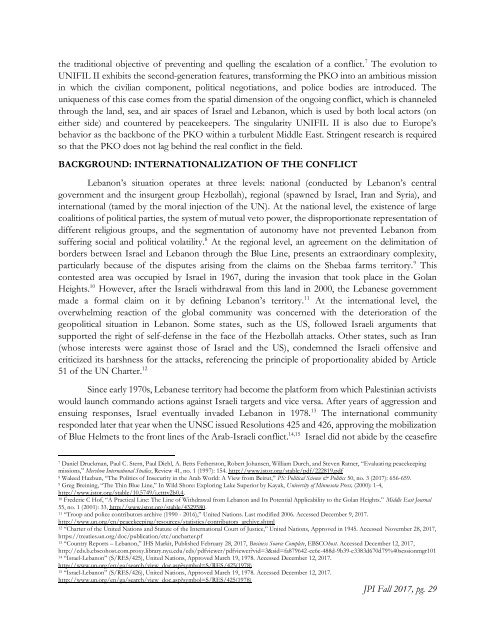Fall 2017 JPI
Create successful ePaper yourself
Turn your PDF publications into a flip-book with our unique Google optimized e-Paper software.
the traditional objective of preventing and quelling the escalation of a conflict. 7 The evolution to<br />
UNIFIL II exhibits the second-generation features, transforming the PKO into an ambitious mission<br />
in which the civilian component, political negotiations, and police bodies are introduced. The<br />
uniqueness of this case comes from the spatial dimension of the ongoing conflict, which is channeled<br />
through the land, sea, and air spaces of Israel and Lebanon, which is used by both local actors (on<br />
either side) and countered by peacekeepers. The singularity UNIFIL II is also due to Europe’s<br />
behavior as the backbone of the PKO within a turbulent Middle East. Stringent research is required<br />
so that the PKO does not lag behind the real conflict in the field.<br />
BACKGROUND: INTERNATIONALIZATION OF THE CONFLICT<br />
Lebanon’s situation operates at three levels: national (conducted by Lebanon’s central<br />
government and the insurgent group Hezbollah), regional (spawned by Israel, Iran and Syria), and<br />
international (tamed by the moral injection of the UN). At the national level, the existence of large<br />
coalitions of political parties, the system of mutual veto power, the disproportionate representation of<br />
different religious groups, and the segmentation of autonomy have not prevented Lebanon from<br />
suffering social and political volatility. 8 At the regional level, an agreement on the delimitation of<br />
borders between Israel and Lebanon through the Blue Line, presents an extraordinary complexity,<br />
particularly because of the disputes arising from the claims on the Shebaa farms territory. 9 This<br />
contested area was occupied by Israel in 1967, during the invasion that took place in the Golan<br />
Heights. 10 However, after the Israeli withdrawal from this land in 2000, the Lebanese government<br />
made a formal claim on it by defining Lebanon’s territory. 11 At the international level, the<br />
overwhelming reaction of the global community was concerned with the deterioration of the<br />
geopolitical situation in Lebanon. Some states, such as the US, followed Israeli arguments that<br />
supported the right of self-defense in the face of the Hezbollah attacks. Other states, such as Iran<br />
(whose interests were against those of Israel and the US), condemned the Israeli offensive and<br />
criticized its harshness for the attacks, referencing the principle of proportionality abided by Article<br />
51 of the UN Charter. 12<br />
Since early 1970s, Lebanese territory had become the platform from which Palestinian activists<br />
would launch commando actions against Israeli targets and vice versa. After years of aggression and<br />
ensuing responses, Israel eventually invaded Lebanon in 1978. 13 The international community<br />
responded later that year when the UNSC issued Resolutions 425 and 426, approving the mobilization<br />
of Blue Helmets to the front lines of the Arab-Israeli conflict. 14,15 Israel did not abide by the ceasefire<br />
7 Daniel Druckman, Paul C. Stern, Paul Diehl, A. Betts Fetherston, Robert Johansen, William Durch, and Steven Ratner, “Evaluating peacekeeping<br />
missions,” Mershon International Studies, Review 41, no. 1 (1997): 154. http://www.jstor.org/stable/pdf/222819.pdf<br />
8 Waleed Hazbun, “The Politics of Insecurity in the Arab World: A View from Beirut,” PS: Political Science & Politics 50, no. 3 (<strong>2017</strong>): 656-659.<br />
9 Greg Breining, “The Thin Blue Line,” In Wild Shore: Exploring Lake Superior by Kayak, University of Minnesota Press, (2000): 1-4,<br />
http://www.jstor.org/stable/10.5749/j.ctttv2b0.4.<br />
10 Frederic C Hof, “A Practical Line: The Line of Withdrawal from Lebanon and Its Potential Applicability to the Golan Heights.” Middle East Journal<br />
55, no. 1 (2001): 33, http://www.jstor.org/stable/4329580.<br />
11 “Troop and police contributors archive (1990 - 2016),” United Nations. Last modified 2006. Accessed December 9, <strong>2017</strong>.<br />
http://www.un.org/en/peacekeeping/resources/statistics/contributors_archive.shtml<br />
12 “Charter of the United Nations and Statute of the International Court of Justice,” United Nations, Approved in 1945. Accessed November 28, <strong>2017</strong>,<br />
https://treaties.un.org/doc/publication/ctc/uncharter.pf<br />
13 “Country Reports – Lebanon,” IHS Markit, Published February 28, <strong>2017</strong>, Business Source Complete, EBSCOhost. Accessed December 12, <strong>2017</strong>,<br />
http://eds.b.ebscohost.com.proxy.library.nyu.edu/eds/pdfviewer/pdfviewer?vid=3&sid=fa879642-ee6c-488d-9b39-e3383d670d79%40sessionmgr101<br />
14 “Israel-Lebanon” (S/RES/425), United Nations, Approved March 19, 1978. Accessed December 12, <strong>2017</strong>.<br />
http://www.un.org/en/ga/search/view_doc.asp?symbol=S/RES/425(1978)<br />
15 “Israel-Lebanon” (S/RES/426), United Nations, Approved March 19, 1978. Accessed December 12, <strong>2017</strong>.<br />
http://www.un.org/en/ga/search/view_doc.asp?symbol=S/RES/425(1978)<br />
<strong>JPI</strong> <strong>Fall</strong> <strong>2017</strong>, pg. 29
















